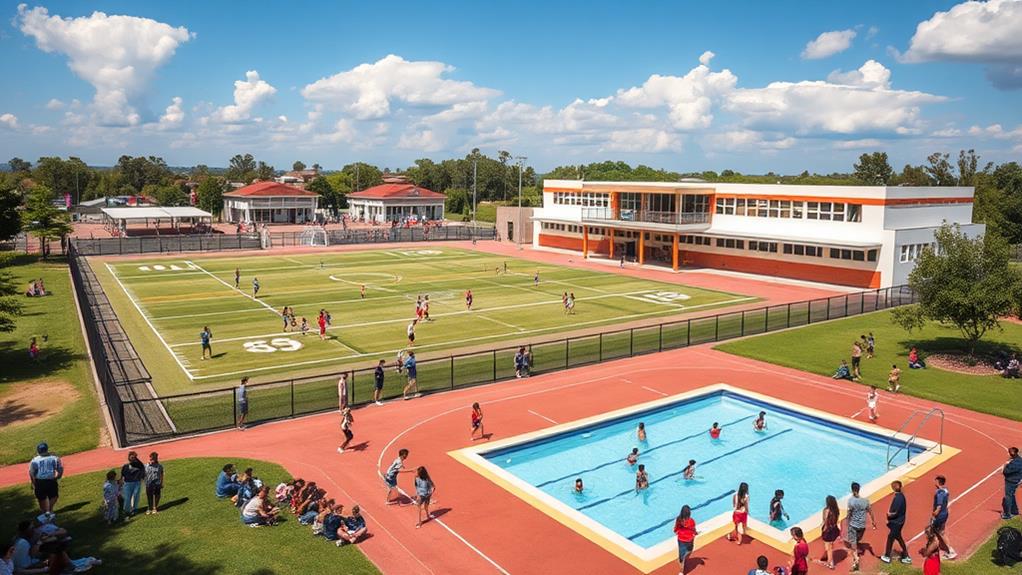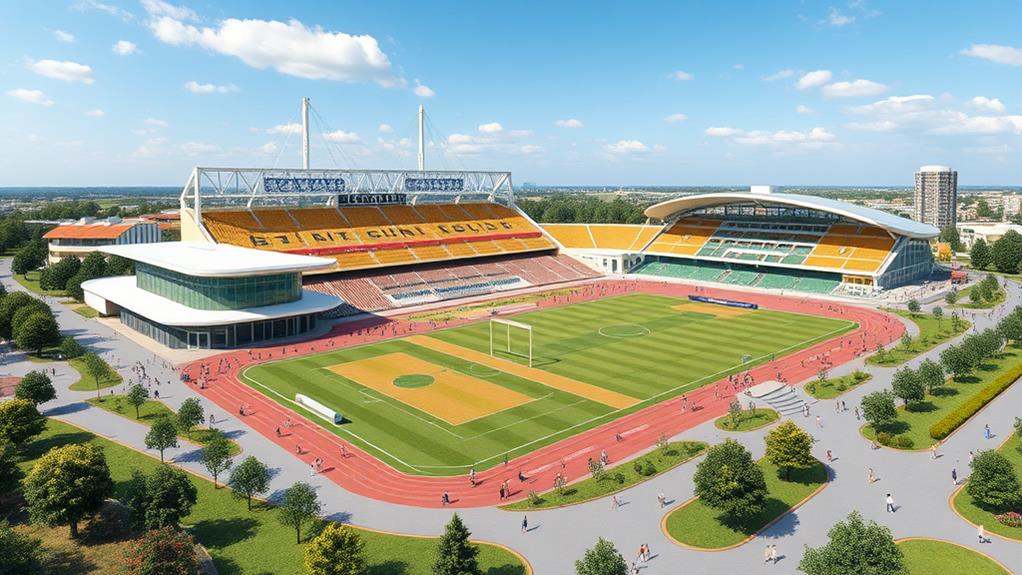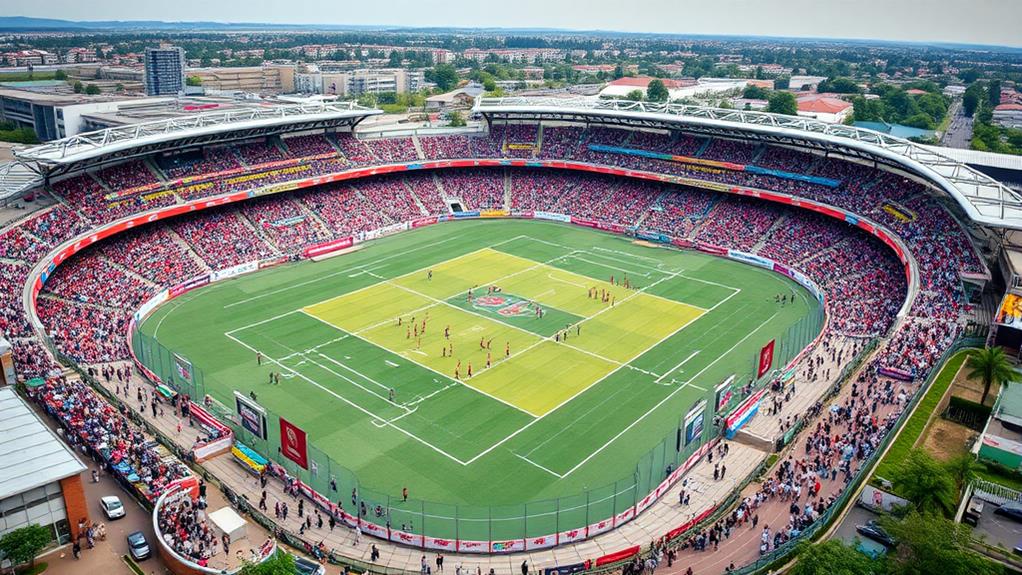Sports facilities and infrastructure are crucial for community health and economic vitality. They provide safe spaces for exercise and recreation, promoting physical activity and reducing the risk of chronic diseases. For instance, having access to local parks and playgrounds encourages children to engage in outdoor play, helping to combat obesity.
These facilities enhance athlete development and foster local engagement. They offer a platform for athletes to train and compete, improving their skills and performance. Moreover, hosting local and international events attracts spectators, stimulating local economies through tourism and hospitality. For example, a well-maintained stadium can host concerts, festivals, and sports tournaments, generating revenue and creating jobs.
Sports facilities have a significant economic impact. They create jobs, attract tourism, and increase property values, benefiting local businesses. According to a study, every dollar invested in sports infrastructure generates around $1.50 in economic returns. Additionally, sports facilities can increase property values by up to 10%, making surrounding areas more attractive to residents and businesses.
Accessibility and maintenance are key considerations. It's essential to design sports facilities with accessibility in mind, ensuring they cater to diverse community needs. Regular maintenance and effective facility management are also vital to maximize usability and safety. This includes regular inspections, repairs, and upgrades to prevent injuries and ensure the facilities remain in good condition.
In conclusion, sports facilities and infrastructure have a profound impact on community health and economic vitality. By understanding their broader impact, it's clear that these spaces are invaluable for social cohesion and economic growth in local communities.
Importance of Sports Facilities

Sports facilities are crucial for building a healthy community. They provide safe and accessible spaces for people to exercise and engage in recreational activities, promoting physical activity and overall well-being. Regular exercise is essential for maintaining a healthy lifestyle, and sports facilities offer a convenient and enjoyable way to do so.
Well-designed sports facilities enhance athlete development. They provide environments that support skill improvement and competitive performance. For example, a well-equipped track and field facility can help athletes improve their speed and agility, while a state-of-the-art swimming pool can enhance their swimming techniques.
This, in turn, contributes to community engagement, as local events and training sessions bring people together and foster a sense of community.
Sports facilities stimulate economic development. They attract events that generate tourism, creating job opportunities in related sectors like sports and hospitality. For instance, a modern stadium can host international sporting events, drawing in tourists and generating revenue for local businesses.
This investment in sports infrastructure represents a long-term commitment to a community's well-being, promoting teamwork, sportsmanship, and a higher quality of life for all involved.
Current Trends in Infrastructure
Modern Sports Facilities Emphasize Accessibility and Inclusivity
Today's sports facilities prioritize accessibility, ensuring that everyone, including individuals with disabilities, can fully engage in sports and recreational activities.
For instance, wheelchair-accessible ramps, elevators, and adaptive equipment enable people with disabilities to participate alongside their able-bodied counterparts. This focus on community development enhances participation and encourages diverse groups to come together.
Sustainable Construction Practices Are Now the Norm
Sustainable construction practices are standard in modern sports facilities, featuring eco-friendly materials and energy-efficient systems.
Many facilities use recycled materials, solar panels, and rainwater harvesting systems, reducing environmental impact and promoting a healthier planet for future generations.
Multi-Purpose Designs Maximize Community Use
Multi-purpose designs are becoming increasingly popular, allowing venues to host various events beyond traditional athletic competitions.
For example, sports facilities may host concerts, festivals, or community events, fostering engagement through a variety of activities and maximizing community use.
Advanced Technology Enhances the Spectator and Athlete Experience
The integration of advanced technology, such as smart seating with real-time stats and virtual reality training, is transforming the spectator and athlete experience.
This technology provides a more immersive experience for spectators and enhances athlete performance through data-driven training.
Health and Safety Protocols Take Center Stage
In response to recent global health challenges, health and safety protocols are a top priority.
Enhanced sanitation measures, such as touchless entry systems and increased hand sanitizer stations, support social distancing and crowd management, ensuring a safe environment for all users.
Design and Planning Considerations

Designing a Successful Sports Facility
To create a successful sports facility, it is essential to conduct a thorough needs assessment that addresses the diverse requirements of various sports and user groups. This assessment should prioritize accessibility and inclusivity, ensuring that individuals with disabilities can fully engage with the facility. Adhering to ADA compliance is crucial in achieving this goal.
Sustainability is Key
Incorporating sustainable design elements is vital in minimizing environmental impact while reducing operational costs. This can be achieved by utilizing renewable materials and implementing energy-efficient designs. For example, using solar panels or wind turbines can reduce reliance on non-renewable energy sources.
Multi-Purpose Facilities
Designing multi-purpose facilities that can accommodate a variety of events beyond sports is increasingly favored. This approach maximizes usage and enhances community value throughout the year. For instance, a sports facility can also host concerts, festivals, or community events, making it a hub of activity.
Strategic Site Selection
Selecting a strategic site for the facility is critical. Consider factors such as accessibility for users, proximity to public transport, and alignment with local demographic needs. This ensures that the facility integrates seamlessly into the community and encourages higher usage rates.
Maintenance and Safety Protocols
Comprehensive Maintenance and Safety Protocols
Regular Inspections Ensure Safety and Functionality
Regular inspections are crucial for identifying potential safety issues and ensuring that sports facilities meet safety regulations.
These inspections help detect worn-out equipment, damaged structures, and other hazards that can cause injuries. For instance, inspecting the condition of gym flooring, sports equipment, and lighting can help prevent accidents.
Hygiene Protocols Protect Athletes and Spectators
Maintaining health standards through consistent cleaning and sanitization is essential, especially in high-touch areas.
This helps prevent the spread of diseases and illnesses. For example, regularly cleaning and disinfecting locker rooms, showers, and equipment can help reduce the risk of infection.
Emergency Procedures Enhance Response Times
Training staff on safety drills and emergency protocols ensures that everyone knows how to respond effectively during incidents.
This includes knowing what to do in case of fires, injuries, or other emergencies. Having a clear plan in place can minimize response times and prevent further harm.
By implementing these maintenance and safety protocols, sports facilities can minimize risks associated with injuries and enhance the overall experience for users.
A proactive approach to maintenance and safety creates a positive impact on the community and ensures that sports facilities remain a safe haven for all.
Role of Facility Management

Effective facility management is crucial for the smooth operation of sports facilities. It ensures that facilities operate efficiently, meeting the diverse needs of athletes and spectators. Facility managers oversee operational efficiency, scheduling, and resource allocation, allowing users to maximize their experiences.
Safety is a top priority in facility management. Implementing safety protocols and compliance measures ensures the safety and well-being of everyone using the facility.
Regular maintenance and timely repairs are vital to prolong the lifespan of sports infrastructure and minimize operational disruptions.
Facility managers are responsible for budgeting and financial management. They secure funding for necessary upgrades, maintenance, and community outreach initiatives.
This enhances the facility's value and contributes to a better environment for athletes and spectators alike.
In summary, effective facility management is essential for thriving sports facilities. It fosters safety, satisfaction, and community engagement, ultimately leading to higher participation rates and increased community involvement in athletic activities.
Community Engagement Strategies
Effective Community Engagement Strategies
Community engagement strategies are crucial for transforming sports facilities into vibrant hubs for local interaction and participation.
By implementing these strategies, you can significantly enhance community involvement and pride.
Outreach Programs
Collaborating with local schools to create tailored sports activities can increase youth participation rates by up to 30%.
For example, offering after-school sports programs can help target local youth and increase engagement.
Affordability Initiatives
Offering affordable ticket pricing and local discounts can boost attendance and foster a sense of belonging.
Studies show that these efforts can increase local event attendance by as much as 25%.
Multi-Use Spaces
Designing facilities for diverse community events beyond traditional sports promotes inclusivity and can lead to a 40% rise in overall facility utilization.
For instance, hosting concerts, farmers' markets, or community fairs can make the facility more welcoming to the community.
When local governments implement these strategies, they create a thriving environment where community members can engage, celebrate, and connect, ultimately enhancing the emotional and social fabric of the area.
How can sports facilities and infrastructure be designed to minimize environmental impact and promote sustainability?
Designing sports facilities and infrastructure with a focus on sports sustainability impact minimization is crucial for promoting environmental responsibility. Utilizing eco-friendly materials, implementing energy-efficient technologies, and incorporating green spaces can all contribute to reducing the environmental impact of sports facilities while promoting sustainability for the future.
Economic Impact of Sports Facilities

Sports Facilities: Engines for Economic Growth
Recognizing the significant economic impact of sports facilities, local governments and stakeholders are investing in these venues to stimulate growth. These investments can generate millions in revenue through job creation, tourism, and hosting events, ultimately bolstering community funding.
Economic Benefits of Sports Facilities
Sports facilities create numerous jobs in maintenance, event staff, and other areas.
Job creation is a significant economic benefit, as these jobs contribute to the local economy.
Additionally, sports facilities attract visitors for games and events, generating revenue for local businesses such as hotels and restaurants. This influx of tourists stimulates local commerce, further boosting the economy.
Sports facilities also enhance property values and local commerce, leading to urban revitalization. New businesses and housing developments often emerge, reshaping urban economic landscapes.
Maximizing Economic Benefits through Public-Private Partnerships
Public-private partnerships in sports infrastructure can further enhance these economic benefits, ensuring sustainable community investment.
These partnerships maximize economic benefits and funding, allowing for collaborative projects that benefit the community.
Real Estate Developments and Economic Segregation
Real estate developments around sports facilities often counteract economic segregation, creating mixed-use spaces that promote economic activity.
This leads to a more diverse and thriving local economy.
Investing in Sports Facilities for Growth and Revitalization
Research shows that major league sports facilities can act as catalysts for economic activity, driving demand for urban living spaces and increasing local commerce.
Investing in sports facilities is a strategic move for any community striving for growth and revitalization.
Future Directions in Sports Infrastructure
As investments in sports facilities continue to drive economic growth, attention is shifting toward the future of sports infrastructure. The focus is on creating facilities that not only serve athletic needs but also benefit the community at large.
Sustainable Construction: Sports facilities will be designed to minimize environmental impact. This is achieved by using renewable energy sources, such as solar or wind power, and adhering to green building standards to promote energy efficiency.
For instance, the U.S. Bank Stadium in Minneapolis, Minnesota, uses 31,000 square feet of solar panels to generate electricity.
Multi-Purpose Spaces: Future sports facilities will be designed to host a variety of events. This versatility enhances utility and financial sustainability.
The Banc of California Stadium in Los Angeles, California, for example, hosts athletic competitions, concerts, and community gatherings, making it a hub of activity throughout the year.
Accessibility and Community-Centric Approaches: Ensuring accessibility for individuals with disabilities is a top priority. Facilities are being designed with ADA compliance and inclusive features, such as wheelchair-accessible seating and amenities.
Moreover, community-centric approaches are fostering local engagement through partnerships with schools and organizations, tailoring amenities to meet the unique cultural needs of the population.
For example, the Little Caesars Arena in Detroit, Michigan, offers a sensory-friendly zone for guests with autism or other sensory sensitivities.
Questions and Answers
Why Are Sports Facilities Important?
Sports facilities are essential for community development. They host events that bring people together, fostering a sense of community and social connection. For instance, local sports tournaments and charity runs attract people of all ages, promoting socialization and neighborhood cohesion.
Sports facilities also have a significant impact on public health. Access to sports facilities encourages physical activity, reducing the risk of chronic diseases like obesity, diabetes, and heart disease. Regular exercise, made possible by these facilities, improves overall well-being and reduces healthcare costs.
In terms of youth development, sports facilities provide a safe space for learning essential life skills. They teach teamwork, discipline, and perseverance, shaping young individuals into confident and responsible adults. For example, youth sports leagues and training programs help children develop coordination, communication, and problem-solving skills.
Furthermore, sports facilities boost the local economy. They attract visitors, create jobs, and stimulate local businesses, generating revenue and growth. By hosting regional and national tournaments, sports facilities can bring in significant tourism dollars, benefiting local hotels, restaurants, and shops.
Lastly, sports facilities promote social inclusion. They ensure everyone, regardless of ability, can participate in activities, fostering a culture of diversity and equality. Adaptive sports programs, for instance, provide opportunities for people with disabilities to engage in sports and recreational activities, promoting inclusivity and accessibility.
What Is the Meaning of Infrastructure in Sport?
Sports infrastructure refers to the essential facilities and systems that support athletic activities.
These facilities include stadiums, training centers, and playing fields. For instance, a soccer stadium provides a dedicated space for players to compete, while a training center offers athletes a place to practice and improve their skills.
Investing in quality sports infrastructure boosts community engagement and creates safer environments for athletes. When a community has access to well-maintained facilities, more people are likely to participate in sports, leading to a more active and healthy community.
However, facility maintenance can pose challenges, and accessibility issues must be addressed. For example, ensuring that stadiums have ramps and elevators for athletes with disabilities is crucial.
Funding challenges often arise, but overcoming these hurdles is vital for fostering an active, healthy community that thrives on sports participation.
Governments, organizations, and individuals can work together to secure funding and resources to develop and maintain quality sports infrastructure.
Why Providing Sports Facilities Is an Important Local Issue?
Investing in sports facilities is vital for community building and youth development. These spaces bring people together, promote social inclusion, and provide a platform for residents to engage in physical activities.
For instance, a local basketball court can host community tournaments, fostering a sense of belonging among participants and spectators alike.
Sports facilities significantly impact the local economy. They create jobs, attract visitors, and stimulate economic growth.
For example, a new stadium can generate revenue from ticket sales, concessions, and sponsorships, while also supporting local businesses like hotels and restaurants.
Ensuring access to sports facilities is essential for building a healthier community. By providing these spaces, individuals can adopt a more active lifestyle, reducing the risk of chronic diseases and improving overall well-being.
Moreover, sports facilities can serve as a hub for health education and awareness programs, further promoting a culture of wellness.
In summary, investing in sports facilities is crucial for fostering community engagement, promoting youth development, and boosting the local economy.
What Is the Importance of Facilities and Equipment When Playing?
Quality facilities and equipment are essential for optimal performance and injury prevention in sports. They provide a safe environment, allowing athletes to focus on skill development without the risk of getting hurt. For instance, a well-maintained track with proper cushioning and drainage reduces the risk of falls and injuries, enabling runners to concentrate on their technique and speed.
Access to modern gear boosts motivation, as it provides the necessary tools to improve performance and push limits. For example, having the latest golf clubs with advanced technology can help golfers improve their swing and accuracy.
Well-maintained facilities promote community engagement, encouraging others to join in and creating a supportive atmosphere that fosters collective growth and healthier lifestyles among participants. A clean and well-equipped gym, for instance, attracts more members and encourages them to work out regularly, leading to a healthier community.